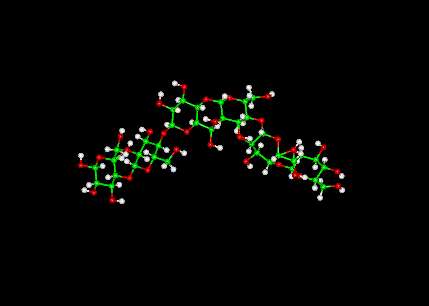Cotton Molecular Structure

For 3-D Structure of Cotton Molecular Structure using Jsmol
Cotton is a soft fibre that grows around the seeds of the cotton plant . The fibre is most often spun into thread and used to make a soft, breathable textile. Cotton is a valuable crop because only about 10% of the raw weight is lost in processing. Once traces of wax, protein, etc. are removed, the remainder is a natural polymer of pure cellulose. This cellulose is arranged in a way that gives cotton unique properties of strength, durability, and absorbency. Each fibre is made up of twenty to thirty layers of cellulose coiled in a neat series of natural springs. When the cotton boll (seed case) is opened the fibres dry into flat, twisted, ribbon-like shapes and become kinked together and interlocked. This interlocked form is ideal for spinning into a fine yarn.
Cotton is composed of pure cellulose, a naturally occurring polymer. Cellulose is a carbohydrate, and the molecule is a long chain of glucose (sugar) molecules.
History
Cotton has been used to make very fine lightweight cloth in areas with tropical climates for millennia. Some authorities claim that it was likely that the Egyptians had cotton as early as 12,000 BC, and they have found evidence of cotton in Mexican caves (cotton cloth and fragments of fibre interwoven with feathers and fur) which dated back to approximately 7,000 years ago. There is archaeological evidence that people in South America and India domesticated independently different species of the cotton plant thousands of years ago.
The earliest written reference is to Indian cotton. Cotton has been grown in India for more than three thousand years, and it is referred to in the Rig-Veda, written in 1500 BC. A thousand years later the great Greek historian Herodotus wrote about Indian cotton: "There are trees which grow wild there, the fruit of which is a wool exceeding in beauty and goodness that of sheep. The Indians make their clothes of this tree wool."
By the end of the 16th century BC, cotton had spread to warmer regions in Americas, Africa and Eurasia.Production The Indian cotton industry was eclipsed during the British Industrial Revolution, when the invention of the Spinning Jenny (1764) and Arkwright's spinning frame (1769) enabled cheap mass-production in the UK. Production capacity was further improved by the invention of the cotton gin by Eli Whitney in 1793.
Production
Today cotton is produced in many parts of the world, including Europe, Asia, Africa, the Americas and Australia, using cotton plants that have been selectively bred so that each plant grows more fibre. In 2002, cotton was grown on 330,000 km² of farmland. 47 billion pounds (21 million t) of raw cotton worth 20 billion dollars US was grown that year.
The cotton industry relies heavily on chemicals such as fertilisers and insecticides, although some farmers are moving towards an organic model of production, and chemical-free organic cotton products are now available. Historically, one of the most economically destructive pests in cotton production has been the boll weevil.
Most cotton is harvested mechanically, either by a cotton picker, a machine that removes the cotton from the boll without damaging the cotton plant, or by a cotton stripper which strips the entire boll off the plant. Cotton strippers are generally used in regions where it is too windy to grow picker varieties of cotton and generally used after application of a defoliant or natural defoliation occurring after a freeze. Cotton is a perennial crop in the tropics and without defoliation or freezing, the plant will continue to grow. Cotton is a close relative of okra and hibiscus.
Uses
In addition to the textile industry, cotton is used in fishnets, coffee filters, tents and in bookbinding. The first Chinese paper was made of cotton fiber, as is the modern US dollar bill and federal stationery. Fire hoses were once made of cotton.
Denim, a type of durable cloth, is made mostly of cotton, as are T-shirts.
The cottonseed which remains after the cotton is ginned is used to produce cottonseed oil, which after refining can be consumed by humans like any other vegetable oil. The cottonseed meal that is left is generally fed to livestock.
Genetically Modified Cotton
GM cotton was developed to reduce the heavy reliance on pesticides. GM cotton is widely used throughout the world with claims of requiring up to 80% less pesticide than ordinary cotton. The International Service for the Acquisition of Agri-Biotech Applications (ISAAA) said that worldwide GM cotton was planted on an area of 67,000 km² in 2002. This is 20% of the worldwide total area planted in cotton. The US cotton crop was 73% GM in 2003.
The introduction of GM cotton proved to be a commercial disaster in Australia - the yields were far lower than predicted, and the cotton plants cross-pollinated with other varieties of cotton potentially causing many legal problems for unsuspecting farmers. However the introduction of a second variety of GM cotton led to 15% of Australian cotton being GM in 2003 with an expectation of 80% in 2004 when the original variety will be banned.